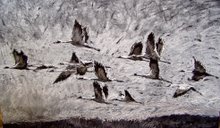

Yea! School is out, which means I finally have some uninterrupted studio time. I had an interesting semester teaching 2D design, which is a basic pre-req for all art majors plus a gen ed course for other majors. It comprises a bunch of little projects designed to teach basic composition, color theory, that kind of thing. It was fun but exhausting, and it's a really good thing to be back to work on my stuff!
So here's what I'm shooting for: I am going to post this particular piece step by step as it unfolds. Everyone keep their fingers crossed that this sucker turns out in the end; otherwise this will be a lesson in what not to do! The subject matter is a really cool building for Grand Junction Steel, a local plant. It is still in operation (as you will be able to see with the high-security gate they have in place!) It is a pastel on a panel I made myself using a wood panel, Kitty Wallis sanded pastel paper, black Bombay ink, and a lot of cussing. It is 48" x 18" in size.
The cussing came into play because I was using 4 sheets of 12x18" paper to cover the wood, the idea being that the seems where the paper meets will be another interesting element in the final piece. I also painted the Wallis paper first using Bombay ink: if you want a nice strong color for a background on Wallis, Bombay is the way to go. It tints it very nicely and doesn't kill the tooth of the paper. Anyway, I adhered the first 3 sheets of paper to my board successfully using Yes Paste, a great product that is a nice, thick, archival kind of paste. It's also a pain in the butt to use when you are dealing with thick, somewhat curled paper that doesn't want to be glued down, thank you very much. So I did these piece by piece, saturated the back of the paper with the paste, forced it into place, then weighed it down for 12 hours or so. I had paste covering my arms and legs by the time I got through this (so I'm not very tidy in the studio, so sue me...) I had this brilliant idea to use PVA (Poly Vinyl Adhesive) for the last piece--also a great glue known for its archival properties and its flexibility over time. Aha! Much easier application! The consistency is more like Elmer's glue, so it was easier to spread and I had a little longer working time. Oh, brilliant me! Yeah, well the other thing Yes Paste is known for is not wrinkling your papers. Yep, 3 of the sheets adhered nicely, the 4th was all lumpy. Sigh. I was able to force it into place eventually but it was a trial.
Okay, here is step one and we'll go from here, assuming that the worst is behind us now!









